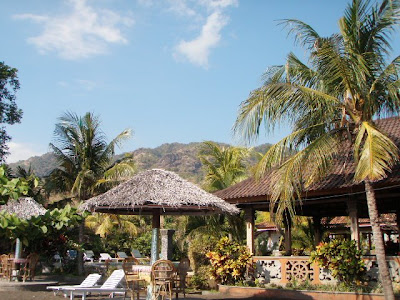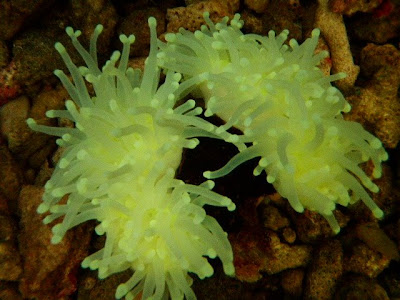My condolences to the families of the deceased ones. Proves that nothing in life is a guarantee and it can end at any moment. Best thing to do is to enjoy life everyday as it was going to be your last - forgive the ones that did you wrong, and move forward - that is my philosophy in life.
One day I will share with you an incident that changed my outlook in life.
Ok let's get into our topic for the day, aquacultured corals. Actually the correct term is maricultured, where the object is grown out in the sea. Aquacultured refers to things grown in a captive environment, like our aquariums. But for our purposes, we will just refer any corals grown in the wild or in our fish tanks as "aquacultured".
After being shocked with all the bleached corals in East Java, we headed back to Bali. Hopped on the ferry again and in an hour, ended up in Northern Bali. This area has the deeperwater acros. The fishermen specialize in growing these species. Acros such as gomezis, loripes, granulosas, lokanis, elegans, desalwiis, hoeksemais, horridas, true echinatas, etc.. are all cultivated here. My suppliers are all familiar with what I like, so I was anxious to see the goods. Just so you know, if you don't work closely with the fishermen, they will end up growing mostly common yellow or green corals for you. They really don't know the species that well and yellow and greens are readily available as broodstock. For any other exporters, this is exceptable. But for us, because our customers are the most demanding, I must get the best species and colors - basically very little or no yellows or greens.
 By the time we checked into a hotel, it was late already. I took this photo of bats flying in and out of this palm tree near the waters edge at the hotel. Pretty cool as I didn't think my camera could pick up anything at night like this.
By the time we checked into a hotel, it was late already. I took this photo of bats flying in and out of this palm tree near the waters edge at the hotel. Pretty cool as I didn't think my camera could pick up anything at night like this. The next morning, I checked out the hotel in more detail. It was the first time staying at a hotel in Northern Bali. I usually stay in East Java side when staying over night. The beach was nice. Not much sand, but black large river rocks dominated the coastline.
The next morning, I checked out the hotel in more detail. It was the first time staying at a hotel in Northern Bali. I usually stay in East Java side when staying over night. The beach was nice. Not much sand, but black large river rocks dominated the coastline. Cool little place to hang out and drink coffee!
Cool little place to hang out and drink coffee! Check out the nice view of Bali mountains.
Check out the nice view of Bali mountains. The pool with a little guy taking a leak!
The pool with a little guy taking a leak! And this is the dining area. It's not the Hilton, but heck it only cost $10 a night! Definitely perfect for backpackers and budget travelers.
And this is the dining area. It's not the Hilton, but heck it only cost $10 a night! Definitely perfect for backpackers and budget travelers. This was kind of cool. This was one of the entrances to the beach!
This was kind of cool. This was one of the entrances to the beach! "And I was kung fu fighting.....!"
"And I was kung fu fighting.....!" After a quick free breakfast of eggs and toast, we were off. We met up with my supplier/aquaculture fisherman at his house. Then it is a 10 minute walk to the beach where a boat was waiting. Not the nice big boat you see here, but a little skinny one, as you will see in the video. Oh yah forgot to mention I managed to upload one of the videos on youtube! Took me ten tries but succeeded. It is a three minute video of as we were leaving the shore. It is nice, as you can see the nice scenery of Northern Bali. You can view the video at the bottom.
After a quick free breakfast of eggs and toast, we were off. We met up with my supplier/aquaculture fisherman at his house. Then it is a 10 minute walk to the beach where a boat was waiting. Not the nice big boat you see here, but a little skinny one, as you will see in the video. Oh yah forgot to mention I managed to upload one of the videos on youtube! Took me ten tries but succeeded. It is a three minute video of as we were leaving the shore. It is nice, as you can see the nice scenery of Northern Bali. You can view the video at the bottom. The tide was coming in and the water was muddy, and my feet sank deep into the mud as we walked to our waiting boat.
The tide was coming in and the water was muddy, and my feet sank deep into the mud as we walked to our waiting boat. We got to our first spot and the fishermen brought up this little cool freshly mounted acro. This appears to be an Acropora insignis, but grows up like a stag. Insignis species usually grow up corymbose shaped or plate like. Strange coral and looks like the coral known as the "Ultimate stag" in the US. It is light purple blue with green corallites, very nice.
We got to our first spot and the fishermen brought up this little cool freshly mounted acro. This appears to be an Acropora insignis, but grows up like a stag. Insignis species usually grow up corymbose shaped or plate like. Strange coral and looks like the coral known as the "Ultimate stag" in the US. It is light purple blue with green corallites, very nice. Here it is again out of the water. Corals don't look good when it is out of the water!
Here it is again out of the water. Corals don't look good when it is out of the water! One of my favorites from Northern Bali, Acropora horrida!
One of my favorites from Northern Bali, Acropora horrida! When the yellow polyps open up on this purple based acro, it is just stunning!
When the yellow polyps open up on this purple based acro, it is just stunning! Here is that "Ultimate stag" again. But this one is about a year old. From this, they will take cuttings and make smaller pieces.
Here is that "Ultimate stag" again. But this one is about a year old. From this, they will take cuttings and make smaller pieces. Just to give you an idea of how big an acropora can grow in the wild, here it is. The one on the left is just few weeks old. The big one is only a year old. Too bad we can't get these kind of growths in our aquariums.
Just to give you an idea of how big an acropora can grow in the wild, here it is. The one on the left is just few weeks old. The big one is only a year old. Too bad we can't get these kind of growths in our aquariums. Some aquaculture bases ready to be mounted.
Some aquaculture bases ready to be mounted. This is a view from the top level of this caramba. This floating platform was used before to grow out groupers. Now it is defunct and my fisherman grows corals around it.
This is a view from the top level of this caramba. This floating platform was used before to grow out groupers. Now it is defunct and my fisherman grows corals around it. A patch of corals crowding below the caramba.
A patch of corals crowding below the caramba. One of the fishermen collecting samples.
One of the fishermen collecting samples. Another view from the upper level of the floating platform. You can see other carambas. Northern Bali is a perfect place to grow corals, seaweed, fish,lobsters, etc...
Another view from the upper level of the floating platform. You can see other carambas. Northern Bali is a perfect place to grow corals, seaweed, fish,lobsters, etc... And here is what I was waiting for. A true echinata! The colors are green based with bluish - purplish tips. I saw these pieces 6 months ago and they were half the size, talk about fast growth! I asked the guys to make smaller pieces from these, as these are too big and too brittle to ship.
And here is what I was waiting for. A true echinata! The colors are green based with bluish - purplish tips. I saw these pieces 6 months ago and they were half the size, talk about fast growth! I asked the guys to make smaller pieces from these, as these are too big and too brittle to ship. A closeup view of the corallites of the echinata. Typical small bottle brush corallites signifies this acropora as the highly desired echinata species. Wonder what colors it would turn into under 20k's?
A closeup view of the corallites of the echinata. Typical small bottle brush corallites signifies this acropora as the highly desired echinata species. Wonder what colors it would turn into under 20k's?Conclusion
Ok guys that is it for today. One thing that was really disappointing was the bleaching just did not effect the wild corals. My fisherman lost most of his entire stock of aquaculture and broodstock. The three species of acros above was what he had left. These didn't get damaged too badly as they were grown deeper down. Normally I pick up the gomezis, hoeksemais, planas, and other specialty ones from him. We will be investing into a caramba for my fisherman to grow the corals out in the deeper section of the reef.
As for the terrorist bombings, I believe Indonesia will find the perpetrators behind the heinous act. The sad thing is that the two suicide guys who blew their heads off for the sake of killing others were probably taught that they would go to heaven or something, if they did this "righteous", as they would interpret it, deed. I really don't understand the radial teachings of Islam.
Nothing to cheer about these sad days here in Indo.
Eddie






























































